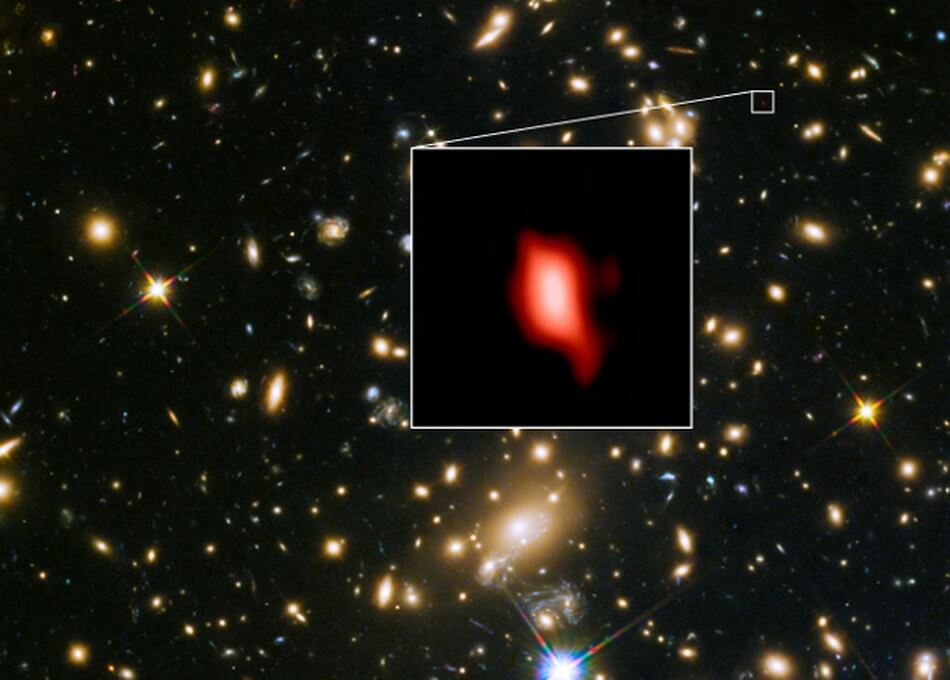
In a far away galaxy called MACS1149-JD1, located 13.28 billion light years away, astronomers found the oxygen, which, in their opinion, could appear there after only 500 million years after the Big Bang. Scientists, who wrote about this opening article in the journal Nature, say that this is the earliest scale age of the Universe the discovery of oxygen. Moreover, outdoor explorers the galaxy has become the most distant galaxy with reliably a certain distance. Models indicate that the first stars in it began to form more than 13.5 billion years ago.
After the Big Bang the Universe was a complicated process — first born quarks, hadrons, and other sub-atomic particles, and followed the first atoms that became part of the primary star material. When was the recombination of the hydrogen and the universe began to cool, she plunged into the “dark ages”. Had not yet lit the first stars were not born and quasars — active galactic nuclei with a supermassive black hole inside. This era ended with the “cosmic dawn”: the emergence of ancient galaxies, which we register today. Their search is important in order to determine how did the evolution of the Universe and the basic chemical elements.
An international team of astronomers under the leadership of Takuya Hashimoto from the University of Osaka to the Sanjo observed by the ALMA telescope for a very distant galaxy MACS1149-JD1 and found a very faint glow of ionized oxygen. Due to the expansion of the Universe the wavelength is initially infrared radiation during its travel in space has increased more than ten times. The redshift of the source indicated that was scientists the signal was emitted 13.3 billion years ago, or after just 500 million years after the Big Bang. This is the largest distance ever recorded oxygen, and its presence shows that this galaxy must exist and an earlier generation of stars.
In addition to the emission of oxygen, was at ALMA, the researchers noted, and weaker radiation of hydrogen with a telescope VLT. The distance to the galaxy, determined by these observations is consistent with that which was received from the oxygen. Thus, MACS1149-JD1 appears to be the most distant galaxy with securely set distance and most distant galaxy ever observed at the VLT or ALMA.

The first enlarged image shows what the galaxy MACS1149-JD1 saw the VLT telescope of the European southern Observatory; the second is how the galaxy saw the space telescope “Hubble”. White contours shows the areas of ionized oxygen, which saw the ALMA telescope
“We see this galaxy in the epoch when the Universe was only 500 million years — and it turns out that at that time she was already populated by Mature stars,” explains Nicolas Laporte, the second author of the article.
“We can use this galaxy to probe an earlier fully unknown period of cosmic history.”
For some time after the Big Bang, the Universe had no oxygen: it was the result of processes of synthesis in the depths of the first stars, and then, when there was a supernova, dispersed in space. Check oxygen MACS1149-JD1 shows that in just 500 million years after the Universe began, these early generations of stars have already formed and managed to produce a lot of oxygen. To find out when the first lights began to emerge, the researchers reconstructed the early history of MACS1149-JD1 at the infrared data obtained from telescopes “Hubble” and “Spitzer”. It turned out that the observed brightness of a galaxy is a good explanation of the model, where the beginning of star formation in the epoch after just 250 million years after the Big Bang. At the same time today it is believed that the “dark ages” have occurred 377 million years after the birth of the Universe — that is, it should be assumed that MACS1149-JD1 started to form in the epoch of recombination.
Thus, MACS1149-JD1 makes scientists wonder about is, when did the first galaxies. Age them an open object indicates that they existed long before that era that we are now able to register them.
In the past the most distant oxygen was discovered in the galaxy that was born after 700 million years after the Big Bang. The amount, researchers estimate, was approximately ten times less than the observed amount of oxygen in the Sun.
In space, discovered oxygen aged about 13.3 billion years
Nikolai Khizhnyak